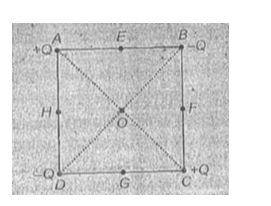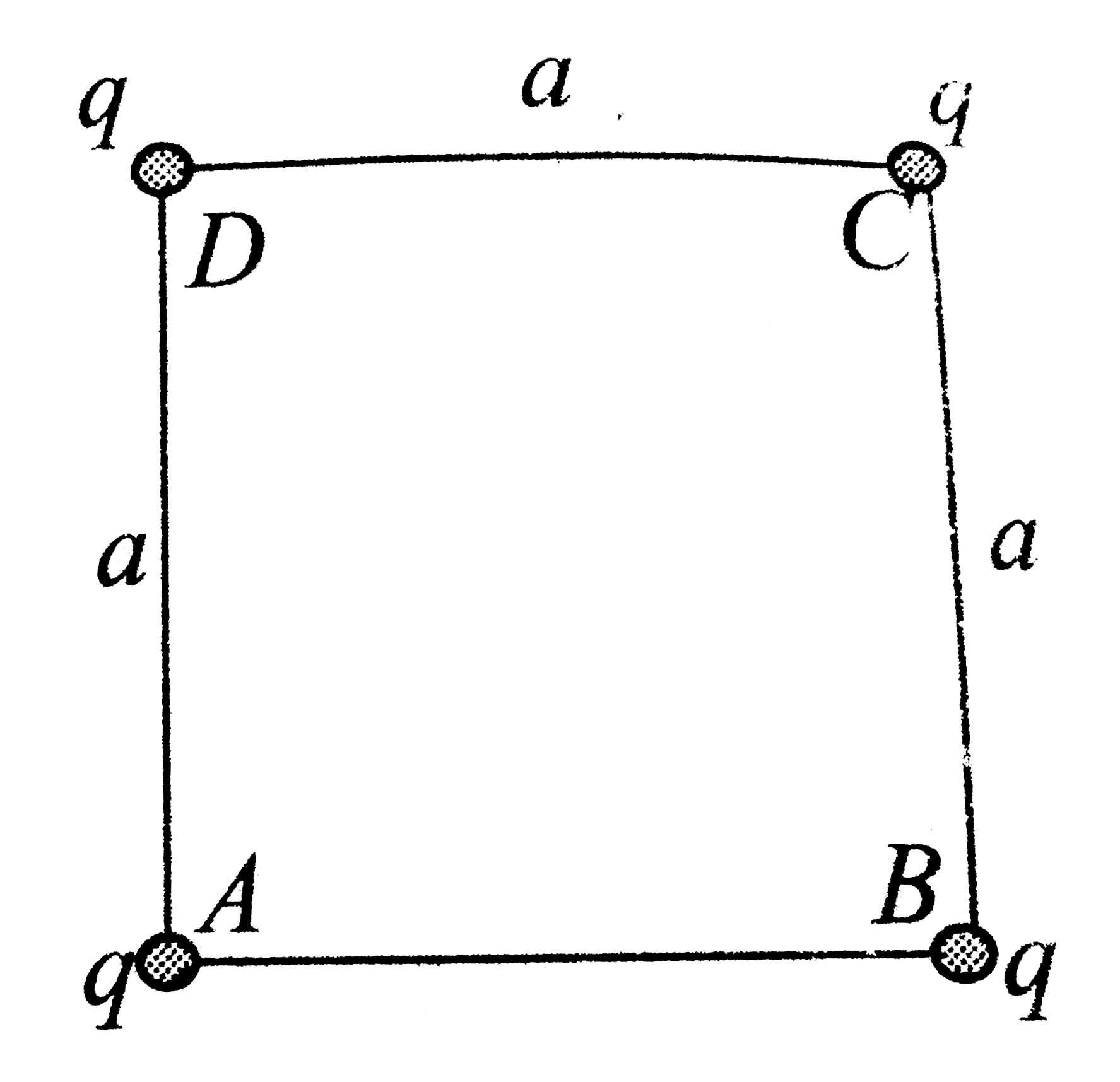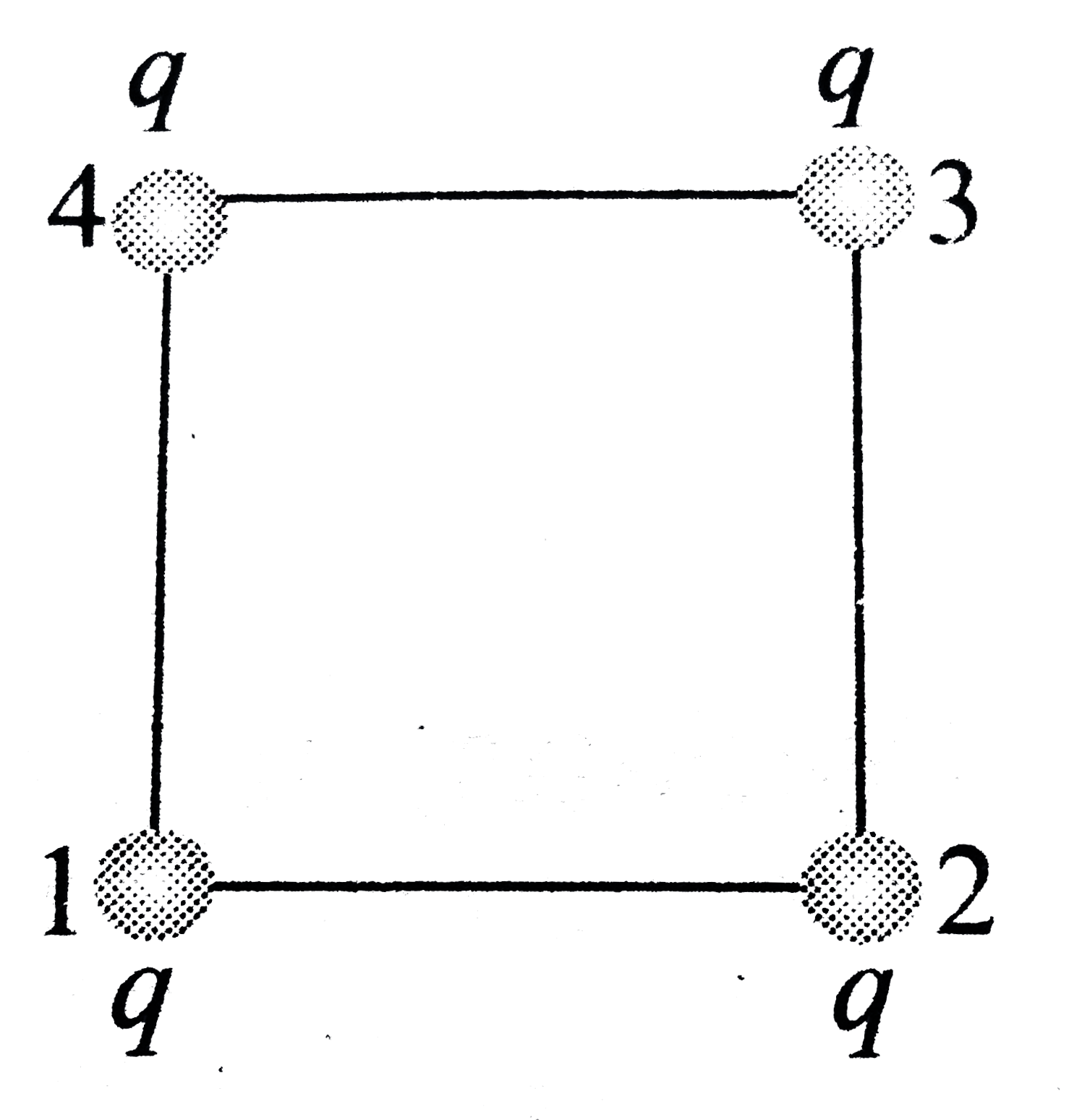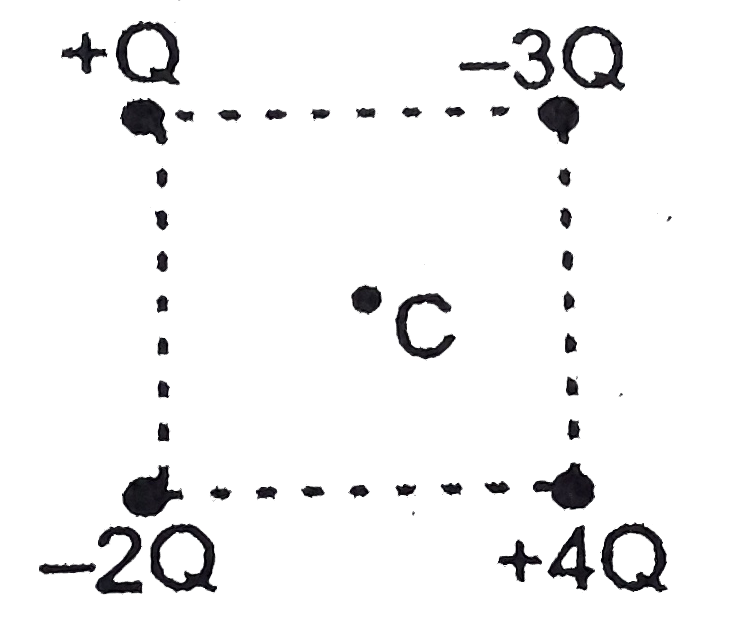Four identical charges Q are fixed at the four corners of a square of side a. The electric field at a point P located symmetrically at a distance a/√2 from the center of the square is
Q2√2πε0a2
Q√2πε0a2
2√2Qπε0a2
√2Qπε0a2
The correct Answer is:B
To solve the problem, we need to find the electric field at point P due to four identical charges Q located at the corners of a square with side length a. The point P is located symmetrically at a distance a√2 from the center of the square.
Step 1: Understanding the Configuration
We have four identical charges, Q, fixed at the corners of a square. Let's label the corners of the square as A, B, C, and D. The center of the square is O, and point P is located at a distance a√2 from O.
Step 2: Calculate the Distance from Each Charge to Point P
The distance from the center O to each corner (A, B, C, D) of the square is given by:
d=a√2
The distance from each charge to point P can be calculated using the Pythagorean theorem. The distance from each charge to point P is:
PO=a√2(distance from center to P)
Using the right triangle formed by the center O and the corner A, we find:
PA=√PO2+OA2=
⎷(a√2)2+(a2)2=√a22+a24=√3a24=a√32
Step 3: Calculate the Electric Field due to One Charge
The electric field E due to one charge Q at point P is given by Coulomb's law:
E=kQr2
where r is the distance from the charge to point P. Therefore:
E=kQ(a√32)2=kQ3a24=4kQ3a2
Step 4: Resolve the Electric Field into Components
Since the charges are symmetrically placed, we can resolve the electric field E into horizontal and vertical components. The angle θ between the line connecting the charge to point P and the horizontal axis can be found using the geometry of the square:
θ=45∘
Thus, the horizontal and vertical components of the electric field due to one charge are:
Ex=Ecos(45∘)=4kQ3a2⋅1√2=4kQ3√2a2
Ey=Esin(45∘)=4kQ3a2⋅1√2=4kQ3√2a2
Step 5: Calculate the Net Electric Field
Since there are two charges contributing to the horizontal component (A and C) and two charges contributing to the vertical component (B and D), the net electric field components will be:
Enet,x=Ex+(−Ex)=0(horizontal components cancel)
Enet,y=Ey+Ey=2Ey=2⋅4kQ3√2a2=8kQ3√2a2
Final Result
The net electric field at point P is directed vertically upwards and has a magnitude of:
Enet=8kQ3√2a2
We have four identical charges, Q, fixed at the corners of a square. Let's label the corners of the square as A, B, C, and D. The center of the square is O, and point P is located at a distance a√2 from O.
The distance from the center O to each corner (A, B, C, D) of the square is given by:
d=a√2
The distance from each charge to point P can be calculated using the Pythagorean theorem. The distance from each charge to point P is:
PO=a√2(distance from center to P)
Using the right triangle formed by the center O and the corner A, we find:
PA=√PO2+OA2=
⎷(a√2)2+(a2)2=√a22+a24=√3a24=a√32
The electric field E due to one charge Q at point P is given by Coulomb's law:
E=kQr2
where r is the distance from the charge to point P. Therefore:
E=kQ(a√32)2=kQ3a24=4kQ3a2
Since the charges are symmetrically placed, we can resolve the electric field E into horizontal and vertical components. The angle θ between the line connecting the charge to point P and the horizontal axis can be found using the geometry of the square:
θ=45∘
Thus, the horizontal and vertical components of the electric field due to one charge are:
Ex=Ecos(45∘)=4kQ3a2⋅1√2=4kQ3√2a2
Ey=Esin(45∘)=4kQ3a2⋅1√2=4kQ3√2a2
Since there are two charges contributing to the horizontal component (A and C) and two charges contributing to the vertical component (B and D), the net electric field components will be:
Enet,x=Ex+(−Ex)=0(horizontal components cancel)
Enet,y=Ey+Ey=2Ey=2⋅4kQ3√2a2=8kQ3√2a2
The net electric field at point P is directed vertically upwards and has a magnitude of:
Enet=8kQ3√2a2
Topper's Solved these Questions
- COULOMB LAW AND ELECTRIC FIELDBOOK - CENGAGE PHYSICSCHAPTER - COULOMB LAW AND ELECTRIC FIELDEXERCISE - Multiple Correct
8 Videos
- COULOMB LAW AND ELECTRIC FIELDBOOK - CENGAGE PHYSICSCHAPTER - COULOMB LAW AND ELECTRIC FIELDEXERCISE - Comprehension
25 Videos
- COULOMB LAW AND ELECTRIC FIELDBOOK - CENGAGE PHYSICSCHAPTER - COULOMB LAW AND ELECTRIC FIELDEXERCISE - Subjective
32 Videos
- COMMUNICATION SYSTEMBOOK - CENGAGE PHYSICSCHAPTER - COMMUNICATION SYSTEMEXERCISE - QUESTION BANK
19 Videos
- Current ElectricityBOOK - CENGAGE PHYSICSCHAPTER - Current ElectricityEXERCISE - QUESTION BANK
40 Videos
Similar Questions
Knowledge Check
Four charges Q-Q, Q-Q are placed at the corners of a square as shown . The potential is zero at points
 AE,F,G,H,OBE,O,G onlyCH,O,F onlyDO only
AE,F,G,H,OBE,O,G onlyCH,O,F onlyDO only
A point charge Q is placed at the corner of a square of side a. Find the flux through the square.
View SolutionFour identical positive point charges Q are fixed at the four corners of a square of side length l. Another charged particle of mass m and charge +q is projected towards centre of square from a large distance along the line perpendicular to plane of square. The minimum value of initial velocity v0 (in m/s) required to cross the square is ?
(m=1gm,l=4√2m,Q=1μc,q=0.5μc)

View SolutionThe magnetic field due to a current carrying square loop of side a at a point located symmetrically at a distance of a/2 from its centre (as shown is)

View SolutionFour identical charges q are placed at the corners of a square of side a. Find the potential energy of one of the charges due to the remaining charges.
 .
.
View SolutionThree charges, each equal to q, are placed at the three. corners of a square of side a . Find the electric field at. the fourth corner.
View SolutionFour small particles charged with equal positive charges Q each are arranged at the four corners of a horizontal square of side a. A unit positive charge mass m is placed at a point P, at a height h above the centre of the square. What should be the magnitude of charge Q in order that the unit charge remain in equilibrium
View SolutionA system consists of charges +q and +q at the opposite corners of a square of sides 2a and −q and −q at the other two corners . Calculate the potential and field at a distance r from the centre of the square along a line parallel to the two sides of the square . Assume a <<r .
View Solution

 .
.